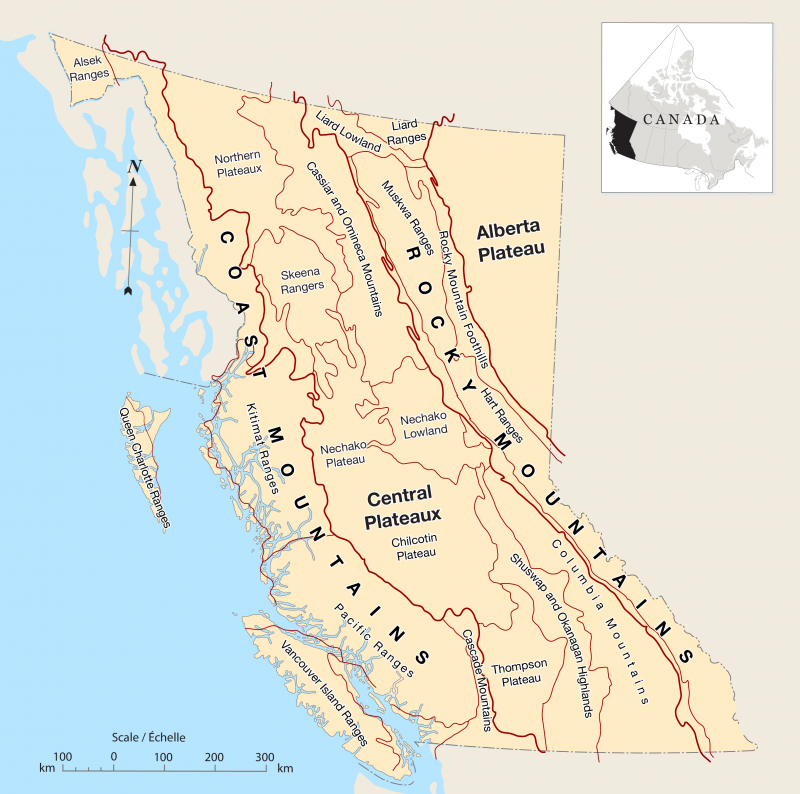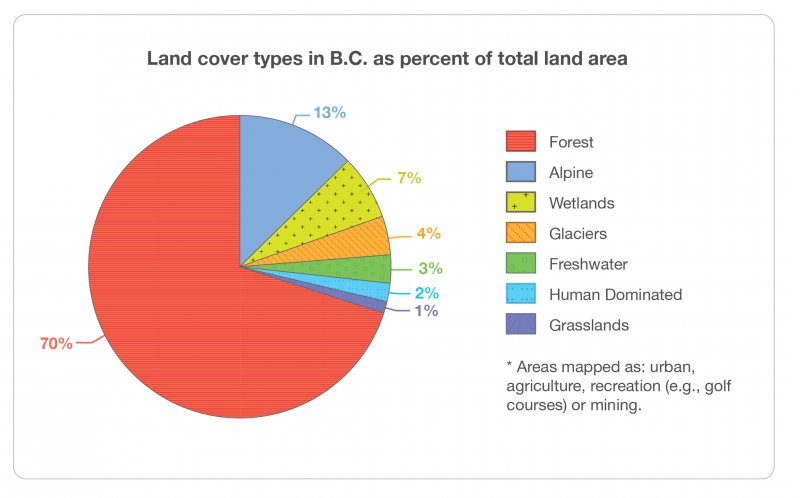8. Physical Geography of British Columbia
Introduction
“Beautiful British Columbia”
“The Best Place on Earth”
“Super, Natural British Columbia”
These official slogans for British Columbia (BC) have all been inspired by the rugged physical geography that characterizes the province. Physical geography is the study of processes and patterns of the natural environment that creates these characteristic landscapes. Physical geography includes a diverse range of natural phenomena, studying, for example, the atmosphere, hydrosphere, biosphere and geosphere. In this chapter we will introduce several physical geography sub-disciplines as they relate to BC’s different regions.
Overview of Regions in British Columbia
BC has an array of physical characteristics that make up its unique and diverse landscape. Because of the variety of physical and cultural regions, the province is sometimes called “a region of regions” (McGillivray, 2005). British Columbia is customarily divided into three main regions, the Interior, the Coast and the Lower Mainland. These are broken up by a loose and often overlapping system of cultural-geographic regions, often based on river basins but sometimes spanning them. Examples of the former are the Kootenays, the Okanagan, and the Chilcotin; examples of latter are the Lillooet country and the Cariboo. Important subareas of these include the Fraser Valley, part of the Lower Mainland, the Fraser Canyon (which overlaps with various regions) and the Robson Valley, which is the uppermost basin of the Fraser River southeast of Prince George. Vancouver Island is considered its own region, as are Haida Gwaii (Queen Charlotte Islands) and the Gulf Islands.

The spatial layout of major features of BC’s physical geography are illustrated in the map in Figure 8.1, which displays some of the major mountain ranges: the Coast Mountains, Columbia Mountains, and Rocky Mountains and plateaus such as the Thomson and Chilcotin Plateaus.
BC’s complex landscape includes varied topography and physiography, many microclimates, and both terrestrial and marine ecosystems. Important characteristics of marine ecosystems include temperature, salinity, seabed configuration and water depth, whereas terrestrial ecosystems are heavily influenced by climatic zones that occur where specific soils, plant and animal communities, and aquatic systems interact with the geologic and geomorphic processes. Marine and terrestrial ecosystems interact to create a unique and vibrant coastal zone.
There are several different biogeoclimatic zones[1] that include diverse vegetation reflecting climatic and physiographic differences. These zones include:
- Alpine tundra
- Spruce—Willow—Birch
- Boreal white and black spruce
- Sub-boreal pine—spruce
- Sub-boreal spruce
- Mountain hemlock
- Engelmann spruce—Subalpine fir
- Montane spruce
- Bunchgrass
- Ponderosa pine
- Interior Douglas-fir
- Coastal Douglas-fir
- Interior cedar—hemlock
- Coastal western hemlock
These biogeoclimatic zones are heavily influenced by the mountains landscape of BC, which has some of the highest mountains in North America. These ranges create orthographic effects, rain shadows and dramatic temperature changes over short horizontal differences.
While the high mountains, especially the Rocky Mountains and Coast Mountains, are known for their cold temperatures, the coastal environment is warm and moist. This warmth and moisture is largely due to the North Pacific Current that runs west to east across the Pacific (stemming from the collision of the Oshiyo Current and Kuroshio Current). Warm ocean air drops most of its moisture as rain and snow as it rises over mountain ranges. This makes BC home to Canada’s wettest climates and hence its most productive forests. The richness of natural resources available in BC are a result of its complex environment and varied ecoregions.

East of the Coast Mountains are the interior plateaus and lower mountains. As the Pacific air flows through the Interior it is influenced by continental air masses. This results in a more continental climate with greater extremes of temperature and precipitation. The region in BC’s southern interior east of the Coast Mountains is the driest while the northeast of BC with its elevated rolling plains (a landscape feature unique in BC) has a cold northern continental climate.

There are 47 official ecoregions in BC[2] as defined by the government of BC. An ecoregion is an area with major physiographic and minor macroclimatic or oceanographic variation.What distinguishes BC from other parts of Canada and North America is the presence of small-scale ecological relationships given its great ecological complexity (Meidinger & Pojar, 1991). In BC, marine and oceanic environments are part of the regional classification of the province given their important climatic influence. There is another level of ecological complexity that occurs within mountainous regions, that of topo-climatic zonation, given the elevation of the landscape which includes mountains and plains.
Attributions
- Figure 8.1 Physiographic region of British Columbia by Hilda Anggraeni from Michael Church, June M. Ryder, 2010. Compendium of forest hydrology and geomorphology in British Columbia. Government of British Columbia. http://www.for.gov.bc.ca/hfd/pubs/docs/Lmh/Lmh66
- Figure 8.2 Land cover types in BC as percentage of total land area by Hilda Anggraeni adapted from http://www.biodiversitybc.org/EN/main/downloads/tnp-2.html
- Figure 8.3 The rain shadow effect on Vancouver by Hilda Anggraeni.
- see http://cfcg.forestry.ubc.ca/resources/cataloguing-in-situ-genetic-resources/about-bec-and-bgc-units/ for more information on BC biogeoclimatic zones ↵
- See http://a100.gov.bc.ca/pub/eswp/res/EcosectionMap.pdf for a detailed map of the ecoprovinces, ecoregions and ecosections of BC. ↵

